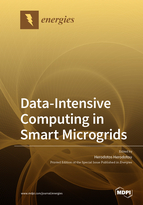Data-Intensive Computing in Smart Microgrids
A special issue of Energies (ISSN 1996-1073). This special issue belongs to the section "A1: Smart Grids and Microgrids".
Deadline for manuscript submissions: closed (31 March 2021) | Viewed by 34790
Special Issue Editor
Interests: smart grids; data analytics; data-intensive computing; data processing systems
Special Issues, Collections and Topics in MDPI journals
Special Issue Information
Dear Colleagues,
Microgrids have recently emerged as the building blocks of smart grids, combining distributed renewable energy sources, energy storage devices, and load management to improve power system reliability, enhance sustainable development, and reduce carbon emissions. At the same time, rapid advancements in sensor and metering technologies, wireless, and network communication, as well as cloud and fog computing, are leading to the collection and accumulation of large amounts of data (e.g., device status data, energy generation data, and consumption data).
The application of big data analysis techniques (e.g., forecasting, classification, and clustering) to such data can optimize power generation and operation in real-time by accurately predicting electricity demands, discovering electricity consumption patterns, and developing dynamic pricing mechanisms. The efficient and intelligent analysis of the data will enable smart microgrids to detect and restore from failures quickly, respond to electricity demand swiftly, supply more reliable and economical energy, and enable customers to have more control over their energy use. Overall, data-intensive analytics can provide effective and efficient decision support for all of the producers, operators, customers, and regulators in smart microgrids to achieve holistic smart energy management, including energy generation, transmission, distribution, and demand-side management.
We are inviting submissions of relevant original research articles or comprehensive reviews to Special Issue of Energies on “Data-Intensive Computing in Smart Microgrids”. The topics of the Special Issue include, but are not limited to, the following:
- Energy data-intensive analytics in smart microgrids
- Data-driven management and control of smart microgrids
- Big data management in smart grids and microgrids
- Cloud and fog computing in smart microgrids operations and management
- Applications of network science in modeling and the analysis of smart microgrids
- Data-driven dynamic pricing mechanisms and strategies in smart grids
- Intelligent decision-making in smart microgrids
- Demand-side management in smart microgrids
- Energy load/demand forecasting for residential, commercial, and/or industrial consumers
- Electricity price forecasting for residential, commercial, and/or industrial consumers
- Power forecasting from renewable energy resources (e.g., solar, wind)
- Management of data for Advanced Metering Infrastructure (AMI) in smart grids
- Data-driven renewable energy integration in smart grids
- Blockchain integration in smart grid and microgrids
Assist. Prof. Dr. Herodotos Herodotou
Guest Editor
Manuscript Submission Information
Manuscripts should be submitted online at www.mdpi.com by registering and logging in to this website. Once you are registered, click here to go to the submission form. Manuscripts can be submitted until the deadline. All submissions that pass pre-check are peer-reviewed. Accepted papers will be published continuously in the journal (as soon as accepted) and will be listed together on the special issue website. Research articles, review articles as well as short communications are invited. For planned papers, a title and short abstract (about 100 words) can be sent to the Editorial Office for announcement on this website.
Submitted manuscripts should not have been published previously, nor be under consideration for publication elsewhere (except conference proceedings papers). All manuscripts are thoroughly refereed through a single-blind peer-review process. A guide for authors and other relevant information for submission of manuscripts is available on the Instructions for Authors page. Energies is an international peer-reviewed open access semimonthly journal published by MDPI.
Please visit the Instructions for Authors page before submitting a manuscript. The Article Processing Charge (APC) for publication in this open access journal is 2600 CHF (Swiss Francs). Submitted papers should be well formatted and use good English. Authors may use MDPI's English editing service prior to publication or during author revisions.
Keywords
- Smart grid
- Smart microgrids
- Renewable energy
- Energy analytics
- Data-driven management
- Dynamic electricity pricing
- Energy load forecasting
- Electricity demand forecasting
- Advanced metering infrastructure
- Blockchain in smart grid/microgrids






